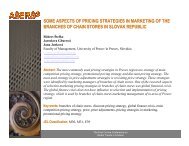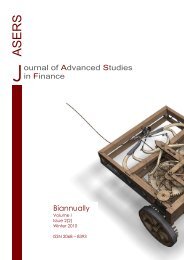Can Shift to a Funded Pension System Affect - ASERS
Can Shift to a Funded Pension System Affect - ASERS
Can Shift to a Funded Pension System Affect - ASERS
Create successful ePaper yourself
Turn your PDF publications into a flip-book with our unique Google optimized e-Paper software.
Theoretical and Practical Research in Economic Fields<br />
2.5<br />
0.045<br />
0.04<br />
2<br />
0.035<br />
0.03<br />
1.5<br />
0.025<br />
1<br />
0.02<br />
0.015<br />
0.5<br />
0.01<br />
0.005<br />
0<br />
1980 1981 1982 1983 1984 1985 1986 1987 1988 1989 1990 1991 1992 1993 1994 1995 1996 1997 1998 1999 2000 2001 2002 2003 2004 2005 2006 2007 2008 2009<br />
Elast. GDP / Production<br />
GR Production (right scale)<br />
0<br />
Figure 3. Delays in world production and GDP response, 1980-2009 (percentage growth and elasticity)<br />
Notes: Five year rolling periods. Production includes agriculture, mining and manufactures.<br />
Source: Based on WTO International Trade Statistics data base.<br />
• Inven<strong>to</strong>ry effects<br />
But recent changes in the apparent trade elasticity are also probably linked <strong>to</strong> global supply chain<br />
management practices. Even under “just-in-time” management (production-<strong>to</strong>-order), geographically fragmented<br />
networks need <strong>to</strong> maintain a minimum level of inven<strong>to</strong>ries (buffer s<strong>to</strong>cks) in order <strong>to</strong> face the usual risks attached<br />
<strong>to</strong> international transportation. While large players try <strong>to</strong> keep their inven<strong>to</strong>ries at the lowest possible level<br />
considering their sales plans and the acceptable level of risk, they tend in the same time <strong>to</strong> force their suppliers <strong>to</strong><br />
maintain large s<strong>to</strong>cks (production-<strong>to</strong>-s<strong>to</strong>ck) in order <strong>to</strong> be able <strong>to</strong> supply them quickly upon request. In addition,<br />
some up-stream suppliers, engaged in highly capitalistic processes such as foundries, need <strong>to</strong> process large<br />
batches in order <strong>to</strong> benefit from economies of scale and lower their unit costs.<br />
As a result, there is always a significant level of inven<strong>to</strong>ries in a global supply chain, translating in<strong>to</strong> a<br />
higher demand for banking loans (Escaith, and Gonguet 2009). When a drop in final demand reduces the activity<br />
of down-stream firms, or/and when they face a credit crunch, their first reaction is <strong>to</strong> run down their inven<strong>to</strong>ries.<br />
Thus, a slow-down in activity transforms itself in<strong>to</strong> a complete stand-still for the supplying firms that are located<br />
up-stream. These amplified fluctuations in ordering and inven<strong>to</strong>ry levels result in what is known as “bullwhip<br />
effect” in the management of production-distribution systems (Stadtler 2008). As long as the down-stream<br />
inven<strong>to</strong>ries have not been reduced <strong>to</strong> their new optimum level, suppliers are facing a sudden s<strong>to</strong>p in their activity<br />
and must reduce their labour force or keep them idle.<br />
The timing and intensity of the international transmission of supply shock may differ from traditional<br />
demand shocks applying on final goods. For example, the transmission index proposed by E-G09 implicitly<br />
assumes that all secondary effects captured by the Ghosh inverse matrix occur simultaneously, while these<br />
effects may propagate more slowly than traditional final demand shocks depending on the length of the<br />
production chain. Also, there might be contractual pre-commitments for the order of parts and material that<br />
manufacturers have <strong>to</strong> place well in advance in order <strong>to</strong> secure just-in-time delivery in accordance <strong>to</strong> their<br />
production plans (Uchida, and Inomata 2009). Indeed, since the 1990s, in high-tech manufacturing, suppliers are<br />
no more minor partners in global supply chains. These suppliers have consolidated, taking a more prominent role<br />
in the industry through a process of mergers and acquisitions (Sturgeon, and Van Biesebroeck 2009). Lynn<br />
(2009) provides an example from the US au<strong>to</strong>mobile industry where key suppliers of parts had a quasi-<br />
34











